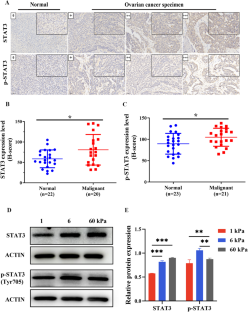Molecular and Cellular Biochemistry ( IF 4.3 ) Pub Date : 2024-04-16 , DOI: 10.1007/s11010-024-04991-5 Sun Chenchen , Qian Xueqian , Lu Yahui , Yuan Yi , Zhang Hui , Bai Lanning , Cheng Min , Han Yangyang

|
The treatment of ovarian cancer remains a medical challenge and its malignant progression is connected with obvious changes in both tissue and cell stiffness. However, the accurate mechanical-responsive molecules and mechanism remains unclear in ovarian cancer. Based on our previous results combined with the crucial regulatory role of STAT3 in the malignant progression of various cancer types, we want to investigate the relationship between STAT3 and matrix stiffness in ovarian cancer and further explore the potential mechanisms. Collagen-coated polyacrylamide gels (1, 6, and 60 kPa) were prepared to mimic soft or hard matrix stiffness. Western blotting, qRT-PCR, flow cytometry, IHC, EdU assays, and TEM were used to evaluate the effect of STAT3 in vitro under different matrix stiffnesses. Furthermore, a BALB/c nude mouse model was established to assess the relationship in vivo. Our results confirmed the differential expression of STAT3/p-STAT3 not only in normal and malignant ovarian tissues but also under different matrix stiffnesses. Furthermore, we verified that STAT3 was a mechanically responsive gene both in vitro and in vivo, and the mechanical response was carried out by altering the migration-related molecules (TNFAIP1) and adhesion-related molecules (LPXN, CNN3). The novel findings suggest that STAT3, a potential therapeutic target for clinical diagnosis and treatment, is a mechanically responsive gene that responds to matrix stiffness, particularly regulation in migration and adhesion in the progression of ovarian cancer.
中文翻译:

STAT3 介导卵巢癌 ECM 硬度依赖性进展
卵巢癌的治疗仍然是一个医学挑战,其恶性进展与组织和细胞硬度的明显变化有关。然而,卵巢癌中准确的机械响应分子和机制仍不清楚。基于我们前期的研究结果,结合STAT3在多种癌症恶性进展中的关键调节作用,我们想要研究STAT3与卵巢癌基质硬度之间的关系,并进一步探讨其潜在机制。制备胶原蛋白涂层聚丙烯酰胺凝胶(1、6 和 60 kPa)以模拟软或硬基质硬度。使用蛋白质印迹、qRT-PCR、流式细胞术、IHC、EdU 测定和 TEM 来评估 STAT3 在不同基质硬度下的体外效果。此外,建立BALB/c裸鼠模型来评估体内关系。我们的结果证实了 STAT3/p-STAT3 不仅在正常和恶性卵巢组织中而且在不同基质硬度下也存在差异表达。此外,我们在体外和体内验证了STAT3是机械响应基因,并且机械响应是通过改变迁移相关分子(TNFAIP1)和粘附相关分子(LPXN、CNN3)来实现的。新的发现表明,STAT3是临床诊断和治疗的潜在治疗靶点,是一种机械响应基因,可对基质硬度做出反应,特别是在卵巢癌进展过程中对迁移和粘附的调节。



























 京公网安备 11010802027423号
京公网安备 11010802027423号